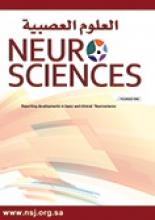Article Figures & Data
Tables
Patients with HS Odds ratio- 95% CI P-value Consanguinity 1st and 2nd cousins 2.037 (0.943 - 4.40) 0.052 First cousin 1.400 (0.630 - 3.11) 0.417 Second cousin 2.698 (0.840 - 8.66) 0.117 HS: hippocampal sclerosis Variables HS group (n=40) Control group (n=80) Gender Male 26 45 Female 14 35 Mean age at onset (range) 11.5 years (1-36) 13 years (1-50) Mean age at diagnosis (range) 30 years (15-54) 31 years (9-68) Parental consanguinity 22 (55.0) 30 (37.5) First cousin 15 (68.0) 24 (80.0) Second cousin 7 (32.0) 6 (20.0) History of febrile seizure 8 (19.5) 9 (11.0) The family history of epilepsy 11 (28.0) 26 (32.0) Seizure freedom * 26 (65.0) 34 (42.5) HS: hippocampal sclerosis, * Seizure freedom after epilepsy surgery in HS group and seizure control in patients with cryptogenic epilepsy at the time of conducting the study






